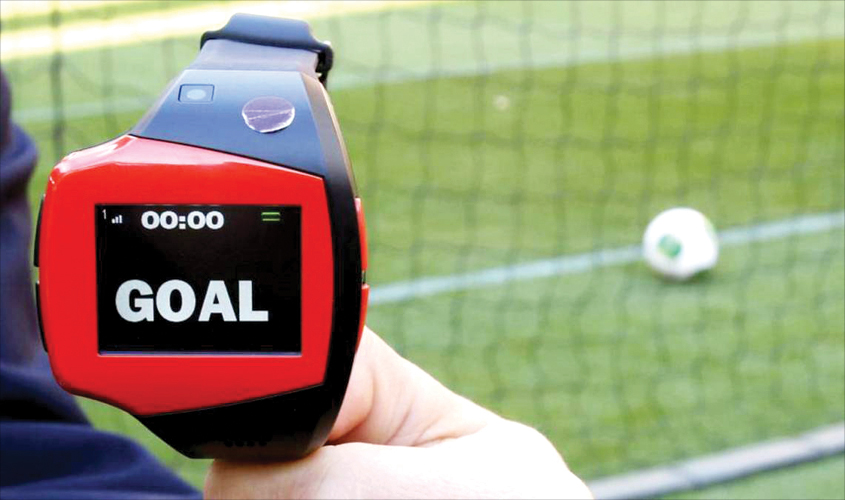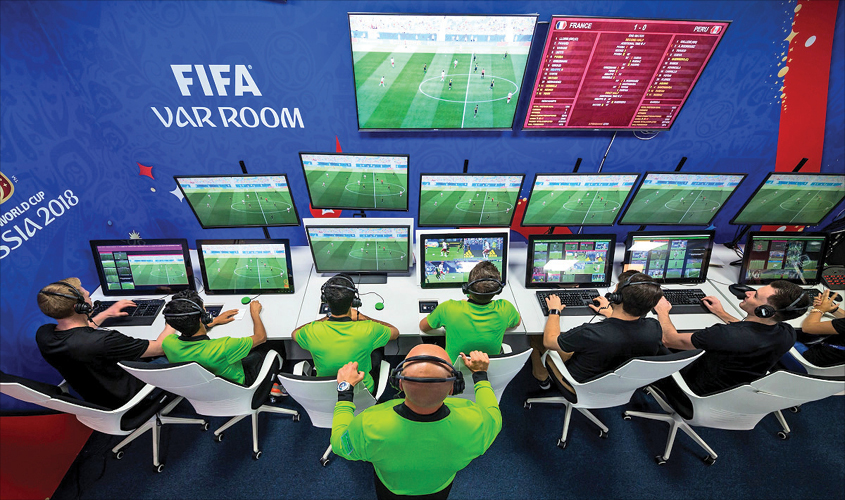Contemporary sport is greatly enhanced by the use of technology, and football—despite the nay-saying luddites—is no exception. Some of the best researchers and engineers are working fulltime around the globe on upgrading and streamlining football technology, from goal-line sensors to player-tracking devices. The most cutting-edge of these advances are showcased every four years at the world’s biggest sporting event, FIFA World Cup. So here are some of the latest hi-tech add-ons to the beautiful game that are making headlines at the 2018 edition of the World Cup.
VAR System
In football, it’s almost impossible to ensure that all decisions the referee takes concerning goals, misses and penalties are fair. But with the use of VAR technology, at least the margin of error can be reduced significantly. The Video Assistant Referee—a setup that involves high-definition cameras, high-performance computers and high-speed network capabilities—was introduced for the first time at FIFA World Cup 2018, to a mixed reception from fans and players alike. But after the initial few games, the football community began to warm up to VAR. It isn’t uncommon now to see players and managers demand for a VAR review after every unfavourable decision by the ref. The VAR review—which takes place at FIFA’s “VAR Room” in Moscow—is handled by a team of professionals equipped with some of the best slow-motion technology available to man. The fibre-linked radio communication channel between the VAR Room and the on-field referee is another important factor of VAR. According to an official statement by FIFA, the assistant referees at the video operation room have access to the audio from the match referee’s communication system, as well as to all the camera angles the VAR is looking at. The system is also used to automatically create VAR-specific graphic templates for TV and the giant screen in the stadium,” according to an official FIFA statement.
NFC football
Adidas’ Telstar 18 is the official match ball for the 2018 FIFA World Cup. It is a result of years of research, just as it is a product of its time. Every Telstar 18 contains an NFC (near-field connectivity) chip embedded in the leather, which means it can be connected to smartphones and other devices for data transfer purposes. For now, this technology is targeted more at general buyers than professional analysts, who already have an abundance of tracking tools and devices at their disposal. “The chip enables consumers to interact with the ball using a smartphone. Upon interaction, each ball generates a unique identifier, unlocking exclusive content and information for the user. The personalised and location-aware experience displays specific details of each ball and provides access to challenges,” according to a FIFA statement. The black-white Telstar 18 is already giving way to its successor, the Telstar Mechta, the red-and-white ball which will be used for the knockout games at the World Cup. The latter, too, features a similar NFC chip.

Goal-line technology
This technology helps referees determine the fates of football teams by establishing whether or not the ball has crossed the goal line entirely (a FIFA criterion that has to be met for a goal to count). Over the years, goal-line sensors used by FIFA have increased in accuracy. These days, every time a goal is scored, the refs get a notification on their tablets and smartwatches. According to an official FIFA statement, “This information is transmitted within one second, which ensures an immediate response from the referee and that there are no stoppages or other forms of interference in the game. The match officials are the only ones to receive a signal.” But how does it work? Well, it works on two levels: it makes use of the camera feeds, and in addition to that, it utilises a network of magnetic sensors installed in underground cables near the goal line.
Electronic performance and tracking systems
EPTS is a technology that enables analysts to track the position of players and the ball in real time. When used in combination with devices like accelerometers, gyroscopes, and heart-rate monitors, the EPTS can even keep track of the players’ physiological parameters. The system comes in three variants. The first is based on an optical tracking apparatus, making use of the live feed generated by the hundreds of cameras installed at the stadium. The second one is powered by highly-accurate local positioning tracking devices embedded in the kit, which follows the movement stats of each player on the field individually. The third variant utilises satellite-powered GPS technology. The EPTS has proved to be highly beneficial for football players in general, as well as for their coaches, who depend on this technology to get the most out of their teams.

Big Bang Referee Smartwatch
Especially designed for the FIFA World Cup, the Big Bang Referee Smartwatch is made by the Swiss luxury watchmaker Hublot. It is a 49-mm titanium watch, with decorated bezels and six H-shaped screws. The watch instantly vibrates and displays “Goal” on the screen as soon as the ball crosses the goal line. Its dial shows the statics of the ongoing game, including the score, the names of goal- scorers, number of cards, player substitutions and match time. The dial also displays the flags of the 32 participating countries. Although the Big Bang Referee Smartwatch was specifically designed for FIFA’s on-field refs, general buyers, too, can buy a version of these, which is priced approximately at $5,000, or Rs 3.4 lakhs.

